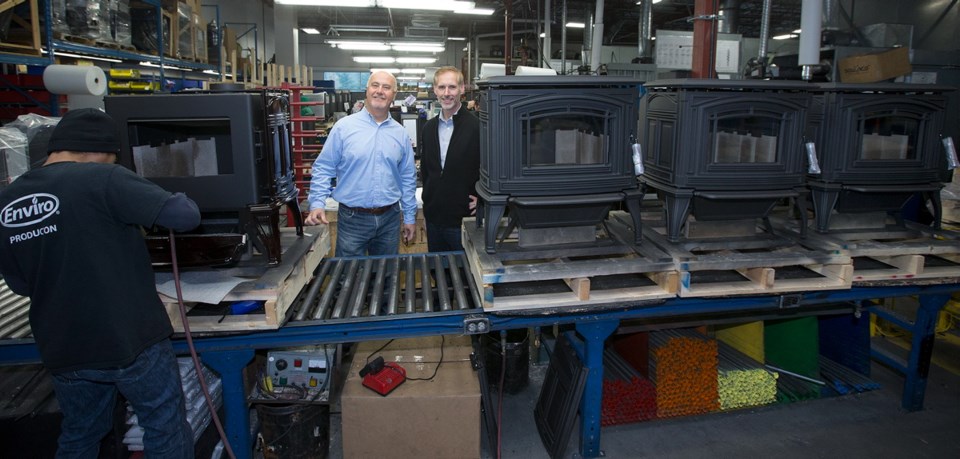The Canadian dollar’s relative weakness to the U.S. greenback should have B.C. manufacturers in a stronger position than they currently are, according to the chairman of the B.C. Alliance for Manufacturing.
Marcus Ewert-Johns said that while the manufacturing sector in B.C. is doing fairly well, it would be doing much better had it taken advantage of opportunities to trim costs, invest in operations and improve productivity when it had the chance.
“The last time the Canadian dollar went low [the high 60-cent range to low 70-cent range], companies should have made capital investments — and most didn’t,” Ewert-Johns said.
If they had improved their productivity, such companies would have been able to take advantage of the current climate, where the loonie is trading at below 80 cents US, he said.
“Manufacturing in B.C. could be doing so much better if productivity was strengthened and a larger skilled labour force was available.”
Currently, the Canadian dollar is trading at a price near 78.50 cents US. While the loonie has been rising against the greenback, this still puts B.C. manufacturers in an advantageous position.
“If B.C’s guys are doing what they should be doing, when the Canadian dollar goes down, they do well,” Ewert-Johns said. “Most manufacturers are in a niche space, where they are doing something unique, and that means they have a global market as an opportunity so they are exporting.
“If they are doing sales in U.S. dollars and their costs are Canadian, then it’s an advantage for them.”
Victoria’s Sherwood Industries has been taking advantage of that opportunity for 28 years.
The company, which manufactures pellet, wood and gas stoves and fireplaces, employs about 200 people at its 100,000-square-foot facility in the Keating industrial area in Saanichton.
Sherwood is reporting a 23 per cent increase in sales, and has improved its bottom line as the vast majority of its sales are international and in American dollars. Fifty-eight per cent of all sales are in the U.S.
Sherwood president Cherbel Yousief said the company has invested more than $4 million in recent years to improve its equipment and productivity.
“We invested heavily and in the [economic] downturn. We slammed on the brakes and did some changes to the business model,” he said, noting those moves translated into a leaner company with more capital to invest. “We have never lagged behind other manufacturers. We invested heavily in automation. … We have always been on the cutting edge of productivity.”
The result has been a company able to react quickly to changes in the marketplace, vice-president Stuart O’Connor said.
“We have expanded our business and now we’re more efficient,” he said.
O’Connor said they have focused heavily on expanding their gas business, which showed the greatest growth potential, and spent research-and-development money on new models to grab more of that market share.
O’Connor said the company’s new production equipment also enables it to work on smaller batches — 18-20 units instead of hundreds at a time. That turns product out faster, cuts down on dead inventory and frees up cash.
“Business models change and companies don’t want to have inventory lying around,” Yousief said.
Victoria’s tech sector is also making short-term hay out of the relatively weak loonie.
Scott Phillips, founder of Starfish Medical, which designs and develops medical devices for the global market, said its profitability is buoyed by the weak dollar.
“But in the long term, if more talent drains to the U.S., it’s bad for the tech industry overall,” Phillips said. “So we wouldn’t welcome further weakening.”
Phillips said the volatility of the Canadian dollar has made planning difficult.
“For purposes of planning and investment, we are assuming an 80-cent dollar. But we have to build scenarios for other rates into our planning,” he said.
Dan Gunn, chief executive of the Victoria Innovation, Advanced Technology and Entrepreneurship Council, said dealing with currency fluctuations is just part of being a Canadian company.
“Our local tech sector is heavily export-focused, so they have had to learn how to manage their operations to mitigate and leverage currency swings as much as possible,” he said. “Sometimes it provides an advantage and sometimes it is a hindrance, depending on your company’s particular markets and business segments.
“One thing is for sure,” Gunn said. “Our companies are much better prepared for these swings and much more savvy in the strategies to deal with them than they were a few decades ago.”



